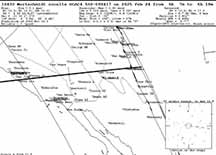
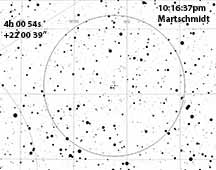
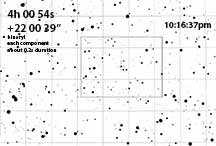
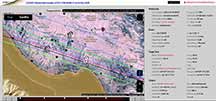
Results from the Nov 16/17 Discovery, and subsequent asteroid photometry
This asteroid was discovered to be a binary asteroid by me on Nov 16, 2025, and confirmed by Jean-Francois Gout and Mattheiu Conjat during the following week, of 2024. We don't have an orbit as of Feb '25, but the orbital period is very close to 23.17 hours, The asteroids are only ~1.9 km in diameter and gravity is weak, my calculation shows the minimu semi-major axis is 17 km if you trust the albedo and density typicals, but for certain a minimum of 10km semi major axis, so there's certainly a chance for missing both of them. Duration this time is only 0.3 seconds for a prior assumed single object, and not 0.52 s as it was last November. So each component will be even less than 0.3s. Will required good conditions to get good data.
Alt=32, Az=274 in Taurus, one quarter of the way from the Plieades to the Hyades.
There will be no moon, unlike the bright 97% moon only 9 degrees away from the brighter Nov 16/17, 2024 discovery event. It will help if you can get out of the city lights, therefore (last time it hardly mattered). Martschmidt is now past retrograde and moving eastward and more rapidly than in Nov '24. Each component will result in an occultation lasting at most about 0.22 seconds. This means we should use the shortest integration possible to get decent data. The stars near the last November occultation, when put on the Watec instrumental magnitude system ("W" magnitudes, in my pages), are within 0.1 magnitude of being "r" magnitudes as shown in C2A's magnitude list for each UCAC4 star. The "r" magnitude for this star UCAC4 560-008417 is 12.9. This will require 4x for our 8SE telescopes with f/3.3 reducer.
I hope it will be clear and fog-free at Cabrillo College Observatory, where I will try to get the Watec to come to focus on the 12" SCT on a convenient day before the event. This will allow a full 1.1 magnitude deeper photometry.
For others seeing my pages for the first time: I make my finder charts for my "team Santa Cruz" who have 8SE Celestron scopes with f/3.3 focal reducers and Watec 910hx cameras. The circular eyepiece chart matches the view for a 32mm 2" Orion Q70 eyepiece on the 8SE telescope, and the square chart for the view of the Watec chip when the f/3.3 focal reducer is in place. These are alt/az scopes, so the top is "up" towards the zenith. The circular eyepiece chart further assumes we're using the 2" diagonal for mounting the Q70 eyepiece. The square chart assumes the Watec camera is mounted in back of the f/3.3 reducer "straight through" (requires the target's altitude be less than 74 degrees) and that the brass BNC video-out connector on the Watec is rotated to be "up". The Q70 eyepiece has a field of view of about 1 degree.
For finding the object, the coordinates needed by the 8SE telescope after a 2-star align, is the RA/Dec "of date", not J2000. And that's the coordinates you'll see on my charts.
Feb 18: My student Bernard has photometric evidence (not perfectly solid as only an approximate magnitude calibrate was done) of an eclipse consistent with the past eclipses, as late as Jan 23. Extending forward, it suggests the components will be about 2 hrs from being in alignment again. This would be favorable for getting both components by staying fairly tight to the predicted path (which still assumes a single object).
 |
 |
 |
 |
as the event time approaches. Each map labelled with the date/time Weather.us was asked for the cloud cover at event time of 10pm Feb 23 local PST.
|
ECMWF as of 11pm 2/22, now zoomed in and the centerline of the predicted path included. All clouds shown, and they are all high clouds. |
Tentative Plan as of midnight Feb 22/23: Google Maps says it's a 2 hr 1 minute drive from Santa Cruz to Mercey Hot Springs. For an event at 10:16pm, we should arrive 1 hr 45 before then, or 9pm, so leave at 6:45pm to allow for traffic and contingencies. That doesn't account for perhaps added time to drive to/pack Bernard's gear in my RAV4 if that's necessary. We don't know if Sandy is joining this, but it sounds like Bernard and Kirk are in. I've not heard from Karl and assume he's not joining us as of this moment. I've laid out 3 stations and a 4th could be set down at the entrance to the rec area (which now looks gated, unlike the old days of Astro 9 when we could just drive up into the hills w/ no gate. But it's still easy to set up in the large parking area. I've tried not to step on tracks from Norm, David D, Vince, Ted Blank.
I'm assuming as of this moment that Bernard can hitch with Sandy, but that's not yet established. Kirk with me as usual. If no Sandy, then Bernard goes with me and Kirk drives separately (maybe with Karl and his gear if we can talk him into it?). I've set out a centerline station, and a northern and southern station along Little Panoche Rd, which Kirk and I are familiar with from a prior expedition here a year ago. Traffic should be very light on that road.
Update 8:30am On OccDay 2/23
The sky dawned fairly blue, but with lots of faint thin cloudiness covering most of the sky. For such a faint difficult event, these would be a serious problem. The progression of satellite images shows this will get worse as the front moves south east slightly during the day. The weather.us forecast also shows cloud cover getting worse until 5pm, and after tthat it gets better, and most impressively better by event time at 10pm. Still, the Santa Cruz area looks bad - especially given that the target is in the western sky where clouds are worse. Assuming the high clouds are 5 miles above our heads - a reasonable estimate for cirrus clouds, then the 30 degree altitude of the target means we must be at least 15 miles to the SE of the cloud front to have those clouds not cover the target. Hence, I still think that Mercey Hot Springs should be our Plan A. It's not impossible that it might be clear enough to get data in Aptos, just unlikely. If some can't abide by a 2 hr drive to Mercey Hot Springs, it's still worthwhile to set up here in town and try this. Check out Weather.us yourself and let me know your decisions as we get later in the day, but again realize that our skies will get WORSE all day until sunset, and only then are predicted to get rather rapidly better. Here's the link: https://weather.us/model-charts/euro/california/total-cloud-coverage/20250224-0100z.html . Remember that the little box showing time, shows CENTRAL time, not PACIFIC time. So you must click not on 10pm today, but instead on midnight in order to see our 10pm cloud map forecast.
Our two-car caravan, on the fly, I decided the trend in the cloud forecasts made the winding drive to Mercey Hot Springs through Tres Pinos, was a doomed effort. We would need to get farther east and south to have any chance of escaping the clouds. That required staying on high speed roads even if it meant longer miles. The next site choice was West Panoche Rd near the intersection with I-5. Sandy and Bernard left before Kirk and I could leave, and were ahead of us, but we were in constant iPhone contact. I had Sandy and Bernard stop at the Subway Sandwiches at I-5/West Panoche and study the sky and help me decide if we need to drive further. The decision was - the clouds were, unlike the predictions, continuing to move south and that we would see nothing at West Panoche Rd. They got back in, and the next and last choice possible before Event Moment, was to get to San Juaquin/Berm area, in the middle of the Central Valley. We got into the area, Kirk was my co-pilot using his iPhone to get on OWc to see where the path went and it was decided Sandy and Bernard would take sites on the south side of the centerline, and Kirk and I on the north side. We wished good luck, and now the race was on to find acceptable observing sites. We ended up on Kamm Rd, after trying an access road a bit north, and having a big dog arrive and chase my car. It was getting late, I got out of the car and studied the clouds long enouth to decide the clouds were moving due east but they were also still covering the target - just BARELY. Another mile south and east might just work. Too chancey with this dog anyway; we drove south to Kamm Rd and drove east until we were just north of the path centerline and I set out Kirk and gear, then I drove on to a place about 45% of the way to the northern limit, and found a good spot and did my set up over a small dry canal (that had a big rat as home!). The target was 4 degrees SE of the line defining the cloud bank. The clouds came up to within 2 degrees of the Plieades. Everywhere in the sky north of that line, was solid clouds. On the south side of that line, it was mostly clear although still with some wisps and a few puffs. But optimistically good nonetheless. As I set up, I kept looking up, and the clouds crept ever so slowly towards the Plieades (the target was about 1/3 of the way from the Plieades to the Hyades), but it stayed clear over the target, and clouds did not cover the target until 4 minutes after the event! We out-ran the clouds by the barest of margins. A matter of a few hundred yards, after a 120 mile drive. Bernard and Sandy had similar good luck, and all of us got recordings.
|
At my site, just after the occultation, looking towards the Plieades, which was just to the lower right of the target star. |
More post-occultation shots... |
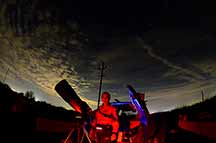 |
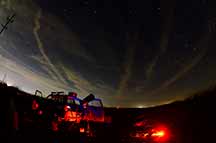 |
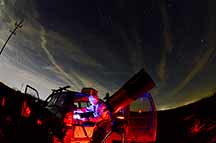 |
|
Repacked with Kirk now, and arriving at a gas station on West Panoche Rd/I-5. |
Meet up with Sandy and Bernard, at the closed Subway shop, to relay our results while still fresh in our minds. |
Bernard recorded directly digital to his small laptop. |
He showed us a clip of his double occultation. in his 10" f/4 Newtonian and hi$ camera, it was very bright and easy to see it as a double event. |
|
|
Bernard's PC, now on OWc and the predicted path, helping show his exact location. |
We were SUPPOSED to be able to observe this from home! Instead, a mad 120 mile drive out to the middle of the Central Valley to just barely barely out run the advancing cloud frontal edge, and snag the event through thin clouds. Happy to have nabbed some science after this! |
I observed at 4x setting, disconnected the monitor. Had no wind during the event, but clearly there were passing light cirrus not lit enough to notice by eye, in the light curves. I used a 3.2px fixed circular aperture. I set up on the top of the concrete little bridge over the canal (dry), on Kamm Ave. About 45% of the way from the nominal centerline and the northern limit. It looks by eye like I have a 2-integration event right at the predicted second of the occultation predictions. There was only 1 other 2-consecutive zero-level event in the record, but a number of single integration zero levels. Ted Blank's and Kirk Bender's data will decide if mine is likely to be real, together with Bernard's duration.
Lat= 36 31 52.64
Long = 120 06 57.09
Elev 56m
I measure it at 1.39km north (perpendicular to the centerline plotted green on OWc. This is 0.9 km north of Kirk's estimated 0.50km from the centerline.
The event time moves 0.0244 sec per km eastward along the path.
The offset in time of event from our site near Helm, CA to Ted Blank's site is 19.0 sec. That is 1/6 of the time it takes for one component to move completely 2 diameters of itself in system orbit, as determined by the mutual eclipses. or 1/3 of the time to move its own diameter of about 4.1km. So, 4.1/3 km = 1.37 km of movement of one component relative to the other as offset in orbital relative position of components while travelling from Helm, CA to Ted Blank. That's rather significant.
My tentative event duration = 0.081s, if real. I measure my site as 1.39km north (perpendicular to the sloping green centerline) of centerline on OWc. Elevation 56m. That's about 0.9 km further north than your chord, Kirk. The larger component size is at least 4 km across, but unlikely to be much more than that, given the photometry eclipses. Let's say 4.1km. The 0.9 km on the ground between our chords, projected onto the sky, I'm guesstimating at about 0.75 km. So we were about 0.37 asteroid radii apart, and it's not unreasonable I might have a short event paired with Kirk's 0.133s event. But Dave Gault can do the sky plane and see if my short possible event is plausible. I hope Sandy got data and adds to our chords. Kirk's timings should help fix the slightly floating UT time of Bernard's two events.
First analysis: 3.2px fixed circular apertures. Median filter horiz/vert,
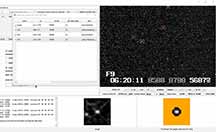 |
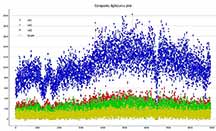 |
 |
 |
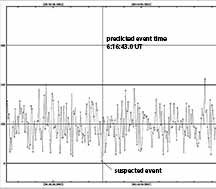 |
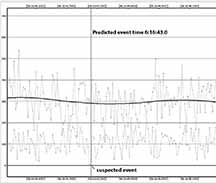 |
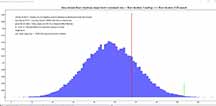 |
Center of my possible event is 6:16:42.76 assuming I can enter the D time in the IOTA form's gray row as the PyOTE time stamp for that data point, and the R similarly for the second zero level point's time stamp.
I also did an anlysis using TME apertures, which was no improvement in S/N or event-finding.
My goal here was to force PyOTE to determine the times to fill in to my IOTA tentative report assuming my light curve had much less random noise than it did, but still had the suspicious double-zero short event at the time which apparently lines up with Kirk's event. So I went in to the PyMovie analysis #1 output .csv file, and saw the mean level outside of that 'event' was very close to 100, and so I used this and artificially put in pseudo data with much lower noise centered on level=100, and also with the 2-pt correlation corresponding to my actual setting=4x integration. I did this for data from 7 seconds before to 7 seconds after the event. I then went into PyOTE and opened the altered csv file named RN-PyM-Martschmidt0225-flattened, asked PyOTE to find best solution for integration blocking, which it did properly, and found the blocking solution the same as the un-altered file, and I accepted it. I then plotted the resulting integration'd data, and I then trimmed out all data before and after that 14 second noise-flattened interval, and then asked it to find an event of size min=2, max=5 points. This time it did find an event. I believe this is the most representative time to be put into the IOTA file report for testing the reasonableness of my absolute times of the 'event' to compare with Kirk's. I've copy/pasted from the log file below, but note my notes! I'm suspicious that because I could only use a minimum of 2 points for this event request, that this may have artificially caused PyOTE's existing software to widen the D and R duration. In the past, I've noticed that PyOTE will warn if you've chosen a minimum interval which seems to spot-on to the actual interval. But since PyOTE won't accept a 1-point duration as a starting interval, I was forced to use 2 points. I believe this is why the PyOTE duration of 0.16s is too long, and the min error interval is zero, max 0.16, and the most reasonable interval is .08s for testing purposes.
magDrop report: percentDrop: 94.0 magDrop: 3.055 +/- 0.362 (0.95 ci) (do NOT pay any attention to the DNR nor timing accuracies below; they're meaningless in this context. Just note the absolute times)
DNR: 10.41
D time: [06:16:42.9002]
D: 0.6800 containment intervals: {+/- 0.0041} seconds
D: 0.9500 containment intervals: {+/- 0.0101} seconds
D: 0.9973 containment intervals: {+/- 0.0184} seconds
R time: [06:16:43.0602]
R: 0.6800 containment intervals: {+/- 0.0041} seconds
R: 0.9500 containment intervals: {+/- 0.0101} seconds
R: 0.9973 containment intervals: {+/- 0.0184} seconds
Duration (R - D): 0.1600 seconds
Duration: 0.6800 containment intervals: {+/- 0.0060} seconds
Duration: 0.9500 containment intervals: {+/- 0.0134} seconds
Duration: 0.9973 containment intervals: {+/- 0.0233} seconds
Note the occultation duration is given at 0.16s, which is greater than the 0.133s at Kirk's location. This is unphysical, but also is likely biased high for 2 reasons: #1 was noted above - PyOTE will not allow starting with a minimum interval shorter than 2 points. #2 this is likely an artifact of the fact I have a PAL 1/50s field interval and Kirk's Watec is NTSC with 1/60s interval, and the fact that we have only 2 integrations at the bottom... not a good situation for PyOTE to determine accurate occultation durations.
Also note that at Kirk's location I see less influence from clouds than I do at my own. However, my event happened after the worst obscuration, which happened before the event and at a few times well after the event, as the reference light curves show.
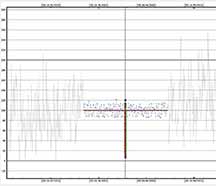 |
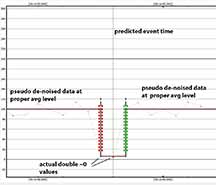 |
PyOTE found a single positive in my data for Martschmidt, 4x integration, near San Joaquin, CA. Light curve is noisy, but I got a 0.1335 sec event just before predicted time of 6:16:43 for that location according to OWC. I tried in PyMovie a nest of several sizes of static apertures, and TME, and found static size 2.0 gave the best DNR (2.65) and NIE sigma distance (10.4). I don't see a second event near this like Bernard observed. I normalized against a reference star, there was a slight downward slope in the reference and tracking stars, presumably from approaching clouds. I was about 500m north of the predicted center line.
center of event: 6:16:42.91 UT
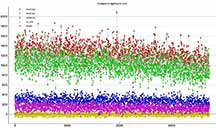 |
 |
 |
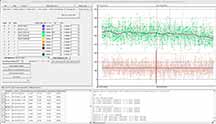 |
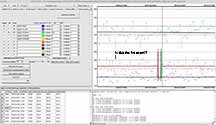 |
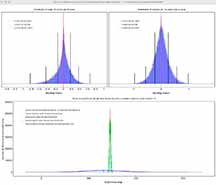 |
GPS Lat: 36°29' 04.52" N, and longitude 120° 00' 22.13"W. Elevation of 60m (including optics above ground level).
For the Occultation of Martschmidt, I carpooled out to the central valley in between Helm and Barrel, CA. We started driving at around 5:40ish and headed to our meeting point at Mercey Hot springs. Sadly, clouds kept pushing us inland. Sandy and I got on the road before Rick and Kirk, and we stayed in the lead during the entire drive to our eventual sites. Eventually landed driving south on I5 in the Central Valley. We missed our turn and kept going south... and amazingly, now saw stars. It seemed to be just clear if we drove a few more miles south. After stopping at Subway Sandwiches at West Panoche Rd intersection, I chose a small paved road near Scarlet Solar as our next destination. As we got there. There was a small amount of cloud in the direction of the target. I had chosen a backup site past Helm, CA along a nicely positioned road perpendicular to the chord. In the end I found a nice gravel patch on the side of "Elkhorn Grade" next to "Elkhorn Bridge (Retired)". Set up my 10" Newtionian telescope in only 25 minutes. The spot was about 380m south of the centerline chord.
I used my Touptek ATR2600M Camera (ROI down to 1280x720 and 59.7ms exposures), no filter, off-axis Touptek GPM462 for autoguding, Meyon coma corrector, and Skywatcher EQ-6r Pro mount.
I got a double occultation at the time predicted. Very, very, obvious. After the main event, my ongoing project for my Astro 80s special studies with Rick, has been to do photometry of Martschmidt itself, to look for the evolution of the binary mutual eclipses this asteroid has been showing. I was able to take about 30 minutes of 3 minute sub frames of Martschmidt as it left the target star. Contamination from the star will be an issue, but it was moving quite fast.
Finding an exact UT times of the occultations is somewhat of an issue based on the fact that my gear does not have any kind of ms accurate time insertion. Syncing the system time using MS Windows built in NTP gives an average error of 0.05s - 0.2s forward of real time, based on the network corrected NIST website (Time.gov). I did a successful sync at 5:15pm PST, although no delay with NIST was measured. Occultation happened at 10:16:43 pm PST. NIST time delay was measured at 12:29am to be at +0.345 s +- 0.02s. Another time offset I did not think about at first is whether that file timestamp is the start or end of exposure. I'm sure I can find out somewhere online. Somewhere Pymovie said something about wanting timing for each frame at the start of the exposure. I decided to add no time offset at all for now because of lack of precise time data. Rick has advised that for confidence, we are going to have to offset my UT times to center for the first occultation on Kirk Benders solid positive, which is properly anchored to UT via the IOTA VTI time stamps algorithm. Therefore, the most critical thing for me to measure is simply the proper relative time offsets for the 4 occultation events. These will be slid to best match Kirk Bender's time absolute, later.
An educated guess would place my times 0.15s ahead of real time.
Here I have written down my exact process for PyMovie and what I did. I decided to redo my analysis again after my first attempt because I was really unsure of my results. This time I took exact notes.
X-ed out of help window
Opened .Ser file
Acknowledged folder creation.
(On first ever boot of Pymovie, It asked if I wanted to use file timestamps, I hit yes, and never saw the popup again… It would have been here in the process.)
Added dynamic mask aperture “Target” on target star. *note: looking back, I should have used fixed instead. I think I added unnecessary noise. (RN: Why do you say you added noise?)
Added dynamic mask aperture “Track1” on nearby star
Added dynamic mask aperture “Track2” on nearby star
Added fixed circular aperture “no-star” in an empty patch of sky.
Hit “analyse”
Hit “clear data and run”
Opened pyote
Hit “read light curve”
Set track 2 as reference star
Smoothed readings set to 200
Made d and r regions
Hit find event
Was unhappy with the first event,
The reason why I was unhappy with the original D and R was that they were weirdly spaced. If I recall, the first D was obviously after the star had disappeared. I think the R was before where it should have been as well. My current D and current R are much much better after I re did D and R regions. Did this a few times. It is slightly better but still a little off. May need more tinkering.
For timing Pymovie just asked if I wanted it to use file timestamps and just accepted it. I realize the way I captured the images is the exact same way the QHY174GPS camera is used. I am assuming that because of the QHY support was added maybe? Because of this, there was no need to mess with 1x, 2x, etc as it can just pull the time from the file. I just left it as is. There was no option for .SER video in the IOTA report, so I chose FITS as that is what is most similar (frame times aren't exactly constant, just whenever the camera is done and the usb traffic is not busy).
First Occultation: PyOTE log file
magDrop report: percentDrop: 100.0 (magDrop cannot be calculated because A is negative)
DNR: 4.71
D time: [06:16:43.0918]
D: 0.6800 containment intervals: {+/- 0.0093} seconds
D: 0.9500 containment intervals: {+/- 0.0245} seconds
D: 0.9973 containment intervals: {+/- 0.0464} seconds
R time: [06:16:43.4213]
R: 0.6800 containment intervals: {+/- 0.0093} seconds
R: 0.9500 containment intervals: {+/- 0.0245} seconds
R: 0.9973 containment intervals: {+/- 0.0464} seconds
Duration (R - D): 0.3295 seconds
Duration: 0.6800 containment intervals: {+/- 0.0138} seconds
Duration: 0.9500 containment intervals: {+/- 0.0307} seconds
Duration: 0.9973 containment intervals: {+/- 0.0549} sec
Second Occultation: PyOTE log file2
magDrop report: percentDrop: 81.9 magDrop: 1.854 +/- 1.271 (0.95 ci)
DNR: 3.55
D time: [06:16:43.8601]
D: 0.6800 containment intervals: {+/- 0.0183} seconds
D: 0.9500 containment intervals: {+/- 0.0481} seconds
D: 0.9973 containment intervals: {+/- 0.1310} seconds
R time: [06:16:44.0399]
R: 0.6800 containment intervals: {+/- 0.0183} seconds
R: 0.9500 containment intervals: {+/- 0.0481} seconds
R: 0.9973 containment intervals: {+/- 0.1310} seconds
Duration (R - D): 0.1798 seconds
Duration: 0.6800 containment intervals: {+/- 0.0272} seconds
Duration: 0.9500 containment intervals: {+/- 0.0627} seconds
I ended up making a second report for the second body as it was not that complicated once I had finished the first one. I could not find out if that is what they wanted me to do or not. I should have asked beforehand. It is all done except for the started observing and stopped observing times in the spreadsheet.
Other notes: In the overall graph there are quite a few long term variations in brightness. That is due to me doing last minute settings changes and perhaps light but invisible clouds . I am not sure if the gain, offset, and exposure time are in metadata of the .ser files but they should be in the second backup recording I did of my laptop screen via Open Broadcaster software. That recorded the whole screen including all last minute things like looking at the OWc website to make sure I was in the right part of the sky and my direct setting changes (and me very tiredly narrating the whole thing).
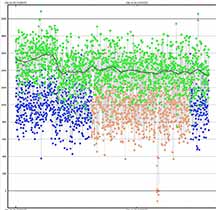 |
Changes in levels probably reflect a mix of thin invisible cloud, and changes in settings after recording began |
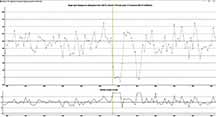 |
First occultation solution |
Second occultation solution |
|
Bernard's total gear, before packing. |
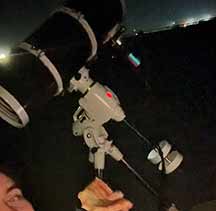 |
Sandy was set up south of Bernard and would have been well placed to get the double occultation including the shorter event Bernard noted. He was set up in time, but at one point the hand paddle slipped, and was wrapped around the 8SE power cable, causing the telescope to lose power, necessitating a start from scratch and new 2-star align and re-acquisition of the target. This was accomplished but just barely in time, and the scope was not focused nor the field ID'd. His examination concluded he had no useable data.
Karl understood the high value of this event and I asked him to get inside the shadow path, at Cabrillo College, even if clouds looked bad. He did so, but clouds were indeed solid and so he was not able to get data.
Dave Gault has taken the raw data and done a sky plot after shifting Bernard's timings by .03s to better agree with Kirk's timings. The sky plane now looks like this...
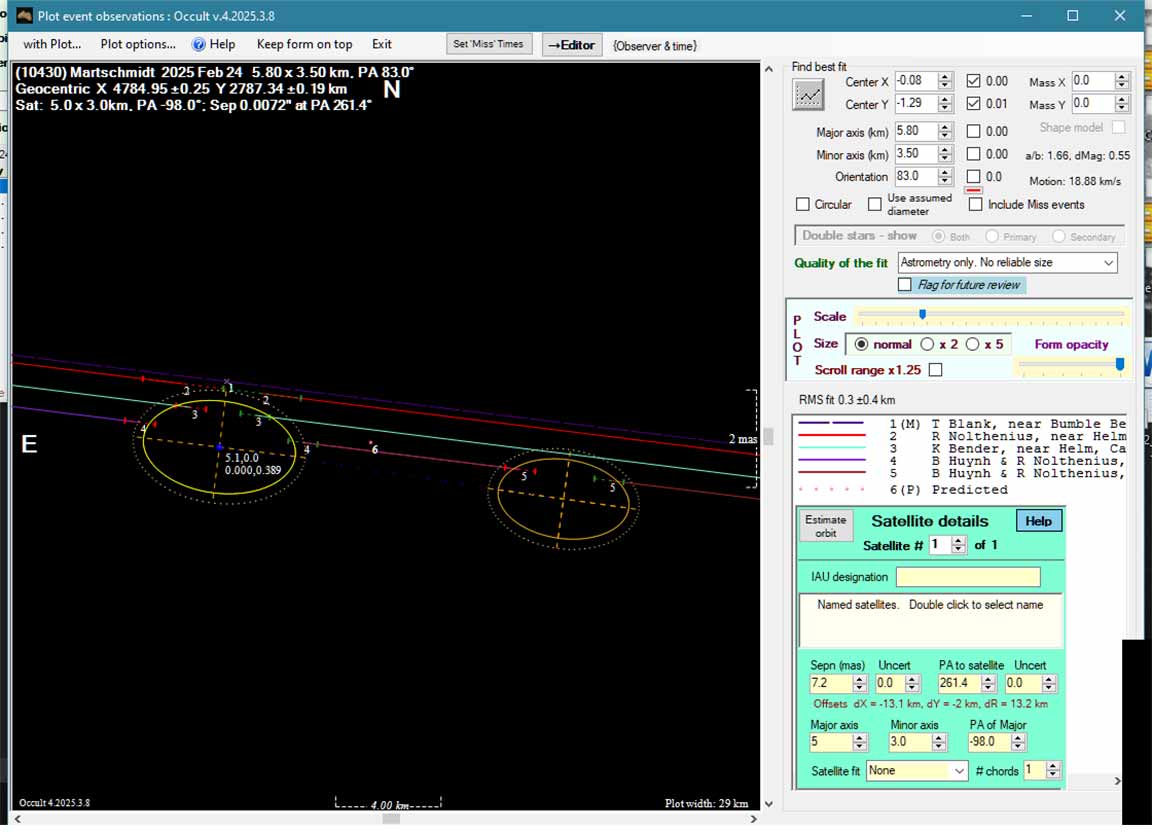 |